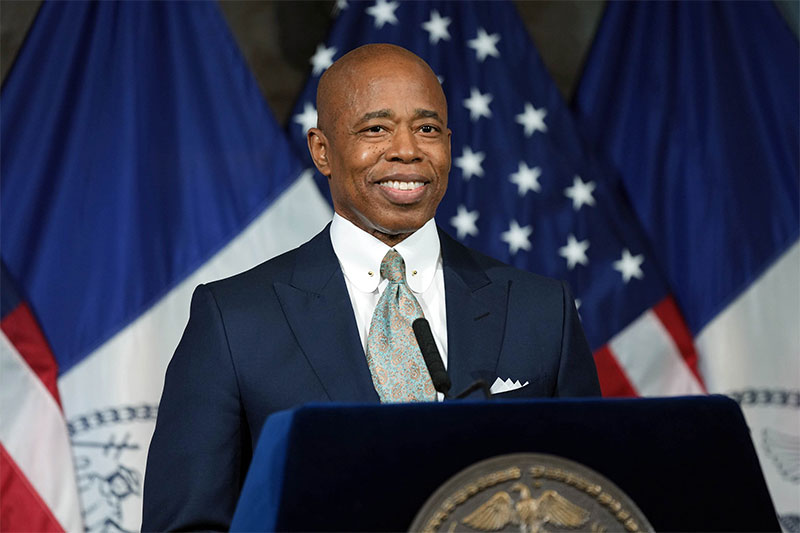NEWYORK: New York city Mayor Eric Adams said that his administration had a clear promise when they took office that public safety is a prerequisite to prosperity.
Delivering his remarks to New York State financial control board, Mayor Adams said that when they took office they had a clear promise which is public safety is a prerequisite to prosperity and we wanted to address the concerns of everyday New Yorkers in general, but specifically working class people.
He said that crime overall fell for the seventh consecutive month in July with notable declines in burglaries and our NYCHA developments are safer today than they were last year.
Regarding illegal weapons, he said that administration have taken over 17,600 illegal guns off the streets since the start of the administration and launched a $500 million blueprint to keep communities safe from gun violence, which would have both helped police shooters across the city by double digits, bringing down those shooters.
“The city has also seen six straight months of double digit drops in several crimes since we directed the NYPD to search offices in the subway system,” he said. “Going back to the subway safety plan that the governor led us on, and we’re seeing true results because of that plan. Aside from the pandemic related issues, major crime in the subways are at the lowest level in 14 years,” he said.
He said that our administration’s Operation Padlock to Protect has already padlocked over 900 illegal smoke shops and seized nearly $60 million in illegal products. He said that crime is down, jobs are up.
“We now have a record high of 4.76 million jobs, nearly 46,000 above the pre-pandemic level. 334,000 of those jobs were created under this administration,” he said.
He said that black unemployment was almost four times the rate of white unemployment, so we zeroed in on it. “We knew that we had to be specific and focused. We decreased black and Hispanic unemployment by close to 30 percent, to 7.3 percent for black unemployment, the lowest figure in half a decade, and 6.5 percent for Latino unemployment,” he said.
On small businesses, he said that NYC administration has additionally broken the record for the most small businesses in city’s history.
“The most small businesses in our city’s history. On top of historic job and business growth, we are keeping the city more affordable for working class New Yorkers. The earned income tax credit we helped push through Albany has generated $345 million in tax credits for over 746,000 low to moderate income New Yorkers, especially parents with children. This put an average of $345 back in the pockets to offset the rising cost of housing, food, and health care,” he said.
Regarding medical debt, he said that we are also wiping out $2 billion in medical debt for qualified low income and severely debt burdened New Yorkers.
“One of the number one causes of going into bankruptcy is medical debt. We’re hitting it straight on and addressing the issue,” he said. “We help CUNY meet the financial challenge of adjusting to declining enrollment. And to address a generational housing crisis, we have only shattered affordable housing records in the last two years, including financing the most affordable housing in one year, but also have the largest affordable housing plan in city history, which will help us hit our moonshot goal of building 500,000 units of new homes by 2032,” he said.
He said that making it easy for families to get by, they reduced the cost of subsidized child care.
“This was so important to our administration. For a family earning $55 a year, child care went from $55 a week is now down to just $5 a week. We’ll continue to work to give every child who wants an early child education and seed access to one. We’re moving towards that goal, and we will accomplish that goal,” he said.
Regarding cleanliness in the city, he said that our city is becoming cleaner and greener. “Day after day, consumer spending remains strong, and we expect to welcome a record level of 68 million tourists to our city,” he said.
He said that our administration has had to do what everyday homeowners are doing, and that is managing the money we spend.
“There’s no great example of effective and responsible fiscal management than the actions we took managing the tremendous challenges we face this budget cycle,” he said.
“This includes the cost of housing and caring for more than 212,000 migrants and asylum seekers. Since the spring of 2022, nearly 64,000 of which are still in city’s care with very limited assistance from the federal government. We accomplished this by being smart and by ensuring we had real programs in place, particularly our 30-day program that was in place for single adults.”
He said that we changed that mindset, and over 95 percent of our contracts are settled, and with almost 96 to 97 percent ratification rates from those city employees and unions, they can stay in the city that they’re making better and safer every day.
He said that these actions, along with the economy that has outperformed, that has performed better than expected, enabled us to close a historically large $7.1 billion gap in January and stabilize the city’s finances.
He said that we stabilized the city’s fiscal outlook and we were able to restore a small number of PEG savings initiatives and relax the hiring and spending freeze.
“We were able to do it without layoffs, without increasing taxes, and maintaining a strong reserve. The adopted budget that was released in June continues the critical work we have done throughout the budget cycle to manage our way through unprecedented challenges and avoided crises,” he said.
“The fiscal year 25 budget remains balanced at $112.4 billion. Out-year gaps are manageable at $5.5 billion, $5.6 billion, and $6.5 billion in fiscal years 26 through 28, respectively. We balanced the budget with a combination of savings and better-than-expected revenues. The adopted budget also achieved savings of nearly $400 million over fiscal year 24 and 25, driven by almost $300 million in debt service savings,” he said.
“Total savings over the two years in this budget cycle is $7.9 billion prior to restoration, driven by our two PEG saving plans as well as Asylum Seeker PEGs in the preliminary and executive budget that brought migrant-related costs down by nearly 30 percent. We also recognized higher-than-anticipated revenues over the same two fiscal years, reflecting better-than-anticipated business and property taxes,” he said.
“However, it is important to note that contrary to what many have incorrectly suggested about surging tax revenues, the growth in fiscal year 24 was essentially flat at about half a percent, or just around $400 million over fiscal year 23,” he said.
“Strong fiscal management includes more than just achieving savings and controlling spending. This year, we have maintained a near-record $8.2 billion in reserves,” he said.
Mayor Adams said that because they made the tough decisions early and managed their way to stable fiscal positions, they were able to protect more than $600 million in critical programs that were funded with stimulus money.
“As a result, in New York, we have not laid off our educators, our police officers, and our governmental employees. Further, we were able to make restorations and substantial investments in critical areas that invest in the programs and services New Yorkers want and deserve. And most importantly, that address the three things that cost them the most. Housing, childcare, and healthcare. We also made substantial investments in cultural organizations, libraries, parks, public safety, transit, and more,” he said.
He said that over the past two and a half years, we’ve had to make tough decisions, but necessary decisions because we have faced extraordinary challenges.



